|
|
|
|
|
|
|
|
 |
Master of the Housebook
|
|
German Northern Renaissance Painter, 15th Century, German graphic artist. The master is named for a series of vigorous and sophisticated drawings of everyday life found in the Hausbuch at Castle Wolfegg. Many of his engravings are in the Rijksmuseum, Amsterdam. His work is thought to have influenced Bosch, Bruegel, and Durer. |
|
|
|
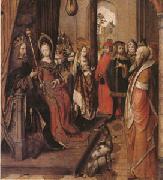 |
Master of the Legend
|
|
active in Cologne ca 1490/1500
Austrian painter and woodcutter. He is named after two altarpiece wings with three scenes from the Legend of SS Cosmas and Damian: the Miraculous Healing of the Leg, A Husband Commending his Wife to the Saints and the Delivery of the False Message by the Devil (Vienna, Ksthist. Mus.). He is thought to have been the earliest disciple of Lucas Cranach the elder in Austria and to have been later influenced by both Albrecht Altdorfer and J?rg Breu the elder. His rather stately figures are in splayed-out, often affected poses, with the feet and knees twisted outwards, appearing almost dislocated. |
|
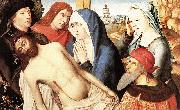 |
Master of the Legend of St. Lucy
|
|
(fl. 1480-1510) was an unidentified Early Netherlandish painter who worked in Bruges, now a city in Belgium. His name comes from for an altarpiece in the church of Saint James in Bruges, which is dated 1480 and depicts three scenes from the life of Saint Lucy. Since then, twenty-five to thirty-five paintings have been attributed to the same hand. He may have trained Spanish students at his studio in Bruges. Many of them are characterized by views of the city of Bruges in the background, and can be dated according to the level of construction of its belfry. He may have trained with Dieric Bouts, and was certainly influenced by Bruges' greatest artist at the time, Hans Memling.
|
|
|
|
|
|
|
|
|
|
|
|
|
|
|
|
|
|
|
|
|
|
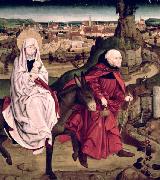 |
Master of the Schotten Altarpiece
|
|
was a German painter, active in Nuremberg during the 14th and 15th centuries. His name is derived from an altarpiece dated to about 1390, which once stood in the church of St. Mary in Schotten. The altarpiece was dismantled in 1828.
|
|
|
|
|
|
|
|
|
|
|
|
|
|
|
|
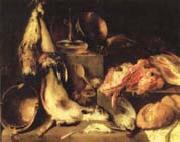 |
Mateo cerezo
|
|
Spanish gifted painter and colorist , c.1626-1666
|
|
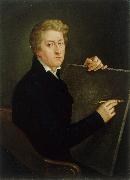 |
Matevz Langus
|
|
Matevž Langus, slovenski slikar in freskant, * 9. september 1792, Kamna Gorica pri Kropi, † 19. julij 1855, Ljubljana.
Rodil se je v fužinarskem kraju pod Jelovico v kovaški družini. Sprva je delal kot žebljar v domači vasi, nato pa se je šolal v Celovcu v delavnici Johanna Schreibersa, pri katerem je ostal šest let. Leta 1817 se je vrnil na Kranjsko in se naselil v Ljubljani. Kasneje bil po priporočilu profesorja Kavčiča sprejet na dunajsko akademijo, vendar je zaradi gmotnih težav opravil le dva letnika študija. Leta 1821 se je ponovno naselil v Ljubljani kot poklicni slikar. V letih 1824 do 1826 je živel v Rimu, kjer je bil vpisan na rimsko Francosko akademijo (L'Academie de France). |
|
 |
Mather Brown
|
|
American Painter, 1761-1831
was a portrait and historical painter, born in Boston, Massachusetts but active in England. Brown was the son of Gawen and Elizabeth (Byles) Brown, and descended from the Rev. Increase Mather on his mother's side. He was taught by his aunt and around 1773 (age 12) became a pupil of Gilbert Stuart. He arrived in London in 1781 to further his training in Benjamin West's studio, entered the Royal Academy schools in 1782 with plans to be a miniature painter, and began to exhibit a year later. In 1784 he painted two religious paintings for the church of St Mary??s-in-the-Strand, which led Brown to found a partnership with the painter Daniel Orme for the commercialization of these and other works through exhibition and the sale of engravings. Among these were large paintings of scenes from English history, as well as scenes from Shakespeare's plays. However, despite their success he began to concentrate on portraiture. His first successes were with American sitters, among others his patron John Adams and family in 1784?C85; this painting is now in the Boston Athenaeum. In 1785?C86 he painted the first portrait of Thomas Jefferson, who was visiting London. He also painted Sir William Pepperrell. His 1788 full-length portrait of Prince Frederick Augustus in the uniform of Colonel of the Coldstream Guards led to appointment as History and Portrait Painter to the Prince, later the Duke of York and Albany. Other paintings include the Prince of Wales, later George IV (about 1789), Queen Charlotte, and Cornwallis. A self-portrait now belongs to the American Antiquarian Society, Worcester, Massachusetts. A falling off of patronage in the mid-1790s, and failure to be elected to the Royal Academy, led Brown to leave London in 1808 for Bath, Bristol, and Liverpool. |
|
|
|
|
|
|
|
|
|
|
|
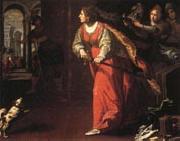 |
Matteo Rosselli
|
|
Italian Baroque Era Painter, 1578-1650
Italian painter. An influential artist of the early 17th century in Florence, he is described by the early sources as being of a gentle disposition and as a dedicated and dignified painter, although he lacked originality and power. His work is characterized by the simplicity, descriptive naturalism and refined colour of the Counter-Reformation art created by such Tuscan artists as Santi di Tito, Bernardino Poccetti, Lodovico Cigoli and Domenico Passignano, yet he was also responsive to Venetian and Emilian art. The son of Alfonso Rosselli and Elena Coppi, he received his early education in Gregorio Pagani's studio, which he attended from as early as 1587. His initial inclination was towards classical and balanced compositions, in which the influence of Andrea del Sarto, whose frescoes he copied in the Chiostro dello Scalzo, is clear. On 26 February 1599 he was admitted to the Accademia del Disegno and in 1605 went to be with Passignano in Rome for six months, greatly enriching his artistic experiences through this contact. He returned to Florence in the same year and, on Pagani's death (1605), completed his master's unfinished works with great success. Pagani's influence can be seen in the bright colours of Rosselli's Adoration of the Magi (1607; Montevarchi, Arezzo, S Andrea). To 1610 belong two monochrome paintings depicting Henry IV at Nantes and Henry IV at Gaudebec |
|
 |
Mattew Ridley Corbet,ARA
|
|
1850-1902
was a Victorian neoclassical painter who attended classes at the Slade School of Art under Alexander Davis Cooper and later at the Royal Academy Schools under Frederic Leighton, President of the Academy. Corbet went to Italy in 1880 and met Giovanni Costa, one of Leighton's friends in Rome. For the next three years he stayed and painted with Costa, eventually becoming one of the leading figures of the Macchiaioli school. He concentrated on Italian landscapes and exhibited at the Grosvenor Gallery, the New Gallery, the Royal Academy and the Paris Salon. |
|
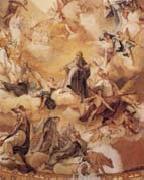 |
Matthaus Gunther
|
|
the most prolific fresco painter of the eight- eenth century in central Europe.
German, 1705-1788
He was an important German painter and artist of the Baroque and Rococo era. Gunther helped develop the rococo style of painting in Bavaria and Tyrol, working on over 40 churches. His known work includes about 70 frescoes and 25 panels. In particular, he was known for his life-like imagery and lively coloring. Gunther studied in Munich from 1723 to 1728 with Cosmas Damian Asam, the older of the two Asam brothers, and perfected his fresco painting in Augsburg. He frequently worked with some of the greatest artists of his time, including the architect Johann Michael Fischer and the plasterer Johann Michael Feuchtmayer and his brother Franz Xaver. |
|
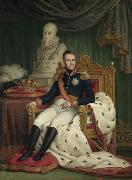 |
Mattheus Ignatius van Bree
|
|
was a Belgian painter, sculptor and architect.
He was born at Antwerp in 1773, was instructed by Regemorter; he afterwards went to Paris, and after having obtained by a 'Cato in Utica' the second prize for Rome, he went to that city in 1797e returning to his native country in 1804.[1] He painted numerous historical pictures, some of which are of large dimensions, and obtained a high reputation in Flanders. His conceptions are frequently poetical, and his compositions graceful, delineated with a light, free, and spirited pencil ; but his colouring is rather too florid in some instances.
He was first professor at the Academy of Fine Arts at Antwerp, and in 1827 its director. Member of several other scientific institutions like the academies of Amsterdam, Rome, Munich and New York. Among his most important works are 'The Patriotism of the Burgomaster Van der Werft,' in the Town-Hall at Leyden, and 'The Death of Rubens,' in the Museum at Antwerp. He brought forward some of the most eminent of the later Flemish painters, among whom are Wappers, De Keyser, F. de Braekeleer, and others of whom their country is justly proud. Van Bree died at Antwerp in 1839.
|
|
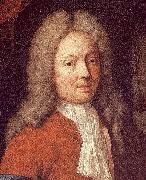 |
Mattheus Terwesten
|
|
Mattheus Terwesten (1670-1757) was a Dutch painter of portraits, architectural, and historical themes. He was court painter to Frederick William I of Prussia and professor of the art academy in Berlin.
Mattheus Terwesten studied with his brother Augustinus Terwesten, Willem Doudyns, and Daniel Mijtens the Younger. In 1695 he traveled via Berlin to Rome, where he stayed until 1699. In Rome he became a member of the painters' circle known as the Bentvueghels, where he earned the nickname "Arend", or eagle. In 1710 he joined his older brother Augustinus and younger brother Ezaias, and when Augustinus died in 1711, he succeeded him as court painter in Berlin, while Ezaias went to Italy, where he married and settled permanently.
His pupils were Herman Diederik Cuipers, Pieter van Cuyck (I), Jan van Gool, Johan Graham, Hendrik van Hulst, Jacob van Nachenius, Andries Storck, and his two sons Augustinus (II) and Pieter Terwesten. |
|
|
|
|
|
|
|
Matthew Ridley Corbet,ARA
|
|
1850-1902
was a Victorian neoclassical painter who attended classes at the Slade School of Art under Alexander Davis Cooper and later at the Royal Academy Schools under Frederic Leighton, President of the Academy. Corbet went to Italy in 1880 and met Giovanni Costa, one of Leighton's friends in Rome. For the next three years he stayed and painted with Costa, eventually becoming one of the leading figures of the Macchiaioli school. He concentrated on Italian landscapes and exhibited at the Grosvenor Gallery, the New Gallery, the Royal Academy and the Paris Salon. |
|
 |
Matthias Grunewald
|
|
German
1475-1528
Matthias Grunewald Galleries
Only religious works are included in his small surviving corpus, the most famous being the Isenheim Altarpiece, completed 1515, now in the Musee d'Unterlinden, Colmar. Its nine images on twelve panels contain scenes of the Annunciation, Mary bathing Christ, Crucifixion, Entombment of Christ, Resurrection, Temptation of St. Anthony and saints. As was common in the preceding century, there are different views, depending on the arrangement of the wings; but the three views available here are exceptional. The third view discloses a carved and gilded wood altarpiece in the centre. As well as being by far his greatest surviving work, the altarpiece contains most of his surviving painting by area, being 2.65 metres high and over 5 metres wide at its fullest extent.
His other works are in Germany, except for a small Crucifixion in Washington and another in Basel, Switzerland. He was asked in about 1510 to paint four saints in grisaille for the outside of the wings of Durer's Heller Altarpiece in Frankfurt. D??rer's work was destroyed by fire and only survives in copies, but fortunately the wings have survived. There are also the late Tauberbischofsheim altarpiece in Karlsruhe, and the Establishment of the Santa Maria Maggiore in Rome (1517-1519), Freiburg, Augustinermuseum. A large panel of Saint Erasmus and Saint Maurice in Munich probably dates from 1521-24, and was apparently part of a larger altarpiece project, the rest of which has not survived. Other works are in Munich, Karlsruhe, and Rhineland churches. Altogether four somber and awe-filled Crucifixions survive. The visionary character of his work, with its expressive colour and line, is in stark contrast to Albrecht Durer's works. His paintings are known for their dramatic forms, vivid colors, and depiction of light. |
|
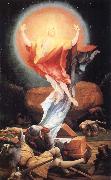 |
Matthias Grunewald
|
|
German Northern Renaissance Painter, ca.1470-1528,was an important German Renaissance painter of religious works, who ignored Renaissance classicism to continue the expressive and intense style of late medieval Central European art into the 16th century. Only ten paintings (several consisting of many panels) and thirty-five drawings survive, all religious, although many others were lost at sea in the Baltic on their way to Sweden as war booty. His reputation was obscured until the late nineteenth century, and many of his paintings were attributed to Albrecht D??rer, who is now seen as his stylistic antithesis. His largest and most famous work is the Isenheim Altarpiece in Colmar, Alsace (now in France). The details of his life are unusually unclear for a painter of his significance at this date, despite the fact that his commissions show that he had reasonable recognition in his own lifetime. His real name remains uncertain, but was definitely not Grunewald; this was a mistake by the 17th-century writer, Joachim von Sandrart, who confused him with another artist. He is documented as "Master Mathis" or "Mathis the Painter" (Mathis der Maler), and as using as surname both Gothart and Neithardt - this last may have been his surname, or more likely that of his wife. He was probably born in Wurzburg in the 1470s. It is possible he was a pupil of Hans Holbein the Elder. From about 1500 he seems to have lived at Seligenstadt, when not working elsewhere. His first dated painting is probably in Munich, dated 1503 on a much later note which apparently records an older inscription. From about 1510 to 1525 he served in the Rhineland as court painter, |
|
|
|
|
|
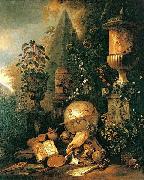 |
Matthias Withoos
|
|
(1627-1703), also known as Calzetta Bianca and Calzetti, was a Dutch painter of still lifes and city scenes, best-known for the details of insects, reptiles and undergrowth in the foreground of his pictures.
Withoos was born in Amersfoort. He studied under Jacob van Campen, at his painters' school just outside the city at his country house, and then with Otto Marseus van Schrieck. When he was 21, Withoos made a trip to Rome with Van Schrieck, and Willem van Aelst. There they joined the group of northern artists known as the "Bentvueghels" ("Birds of a feather"), and Withoos went by the alias "Calzetta Bianca" ("White Hose") a translation of his name into Italian. Withoos' work caught the eye of the cardinal Leopoldo de Medici, who commissioned various paintings from him.
In 1653, the artist returned to Amersfoort.When French troops occupied Amersfoort in the "Disastrous Year" of 1672, Withoos fled from Amersfoort to Hoorn, where he would remain until his death in 1703. |
|
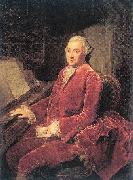 |
Matthieu, Georg David
|
|
German, 1737-1778
German painter and engraver. He received his training as a painter from his father, the Prussian court painter David Matthieu (1697-1755), and his stepmother and aunt, the painter Anna Rosina Lisiewska (1713/16-83). He apparently travelled outside Germany and is known to have gone to Stralsund with the painter Philipp Hackert in 1762. His portraits from this period, including one of Princess Charlotte of Mecklenburg-Strelitz, who married King George III of England, |
|
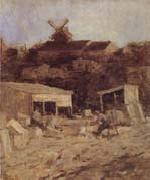 |
Matthijs Maris
|
|
Dutch Painter, 1839-1917
Brother of Jacob Maris. In 1851 he was apprenticed for one year to Isaac Elink Sterk (1808-71); from 1852 to 1855 he attended classes at the Academie in The Hague, and in 1854 he joined the studio of Louis Meijer, where his brother Jacob was also working. It was due to Meijer that in 1855 he was granted a monthly allowance by Queen Sophie to continue his training in Antwerp, where he moved in with Jacob. Through his studies at the Academie, Matthijs met the German painter Georg Laves, who introduced him to the work of the 19th-century German Romantic painters, in particular Ludwig Richter. |
|
|
|
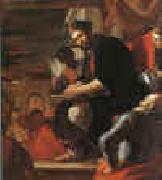 |
Mattia Preti
|
|
1613-1699 Italian Mattia Preti Gallery
Born in the small town of Taverna in Calabria, Preti was sometimes called Il Cavalier Calabrese (the Knight of Calabria). His early apprenticeship is said to have been with the "Caravaggist" Giovanni Battista Caracciolo, which may account for his life-long interest in the style of Caravaggio.
Probably before 1630, Preti joined his brother Gregorio (also a painter), in Rome, where he became familiar with the techniques of Caravaggio and his school as well as with the work of Guercino, Rubens, Reni, Giovanni Lanfranco. In Rome, he painted fresco cycles in Sant'Andrea della Valle and San Carlo ai Catinari. Between 1644 and 1646, he may have spent time in Venice, but remained based in Rome until 1653, returning later in 1660-61. He painted frescoes for the church of San Biago at Modena (app. 1651-2) and participated in the fresco decoration of the Palazzo Pamphilj in Valmontone (documented 1660-61), where he worked along with Pier Francesco Mola, Gaspar Dughet, Francesco Cozza, Giovanni Battista Tassi (il Cortonese), and Guglielmo Cortese.
Jacob blessing his grandchildren, Ephraim and Manasseh, in the presence Joseph and their mother Asenath. Whitfield Fine Art Gallery, London.During most of 1653-1660, he worked in Naples, where he was influenced by the other major Neapolitan painter of his era, Luca Giordano. One of Preti's masterpieces were a series of large frescoes, ex-votos of the plague (which were painted on seven city gates but have since been lost to the ravages of time), depicting the Virgin or saints delivering people from the plague. Two sketches are in the Capodimonte Museum in Naples. The bozzetto of the Virgin with the baby Jesus looming over the dying and their burial parties envisions a Last Judgement presided over by a woman. Preti's salary for the work was 1500 ducats. Preti also won a commission to supervise the construction, carving, and gilding for the nave and transept of San Pietro a Maiella.
Having been made a Knight of Grace in the Order of St John, he visited the order??s headquarters in Malta in 1659 and spent most of the remainder of his life there. Preti transformed the interior of St. John's Co-Cathedral in Valletta, with a huge series of paintings on the life and martyrdom of St. John the Baptist (1661-1666). In Malta one also can find many paintings of Preti in private collections and in parish churches. His increased reputation led to an expanded circle of patrons, and he received commissions from all over Europe.
Preti was fortunate to enjoy a long career and have a considerable artistic output. His paintings, representative of the exuberant late Baroque style, are held by many great museums, including important collections in Naples, Valletta, and in his hometown of Taverna. |
|
|

